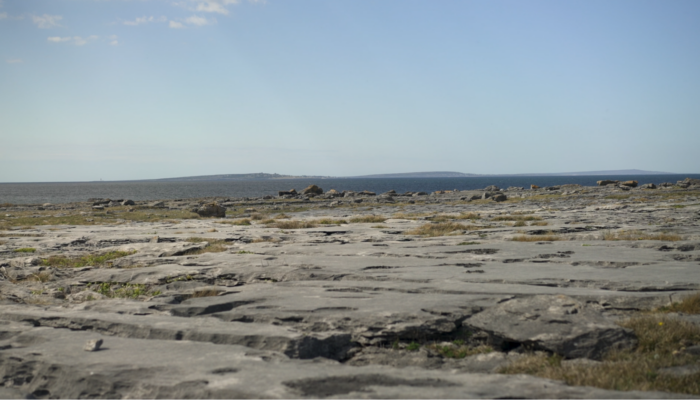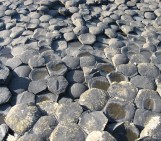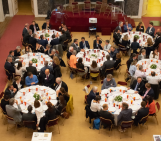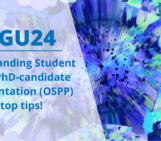
I had the pleasure of interviewing Fergus McAuliffe, the Communications and Public Engagement Manager at iCRAG, University College Dublin in Ireland, to discuss his award-winning project, “Marine Geoscience for All.” During our conversation, Fergus shed light on the innovative ways his project aims to connect the public with marine geoscience through art, dialogue, storytelling, and education. Read on to discover more about Fergus’s vision and the impact of his ground-breaking work.
Hello Fergus and thank you so much for taking the time for this interview. To kick off, could you tell me a little about yourself and your background, and what inspired you to develop the “Marine Geoscience for All” project?
I’m the Communications and Public Engagement Manager at iCRAG – the Science Foundation Ireland Research Centre in Applied Geosciences based at University College Dublin, Ireland where my science communication and research activities include working with artists, teachers, and the media.
Alongside this I am a TV presenter with more than 10 years experience on “10 Things to Know About” on RTE1 TV, where I present science stories focussing on of science storytelling, the natural world and the environment. A number of years ago I was the winner of FameLab International, the world’s largest science communication competition, which kickstarted my science communication career alongside my PhD research in environmental science.
Ireland as an island nation is intimately connected to our seas, yet the link between people, geoscience and the ocean remains somewhat out of sight and out of mind. Our inspiration for the “Marine Geoscience for All” project is to explore that connection with a series of diverse audiences, and to spark a national conversation among public audience across the island.
Can you describe the main goals and objectives of the project?
The goal of our project is to bring together a consortium of geoscience public engagement groupings in Ireland to deliver a nationwide exploration of geoscience for inactive adult audiences, and under-represented school children.
We will work with artist Alan James Burns, the Geological Survey Ireland, Ireland’s Fossil Heritage Educational programme and the Get into Geoscience educational programme to deliver four events on the same day that explore the relationship between people and Ireland’s marine geoscience through the mediums of art, dialogue, storytelling and education. The events will be held simultaneously in four regions (North, South, East and West) on Thursday November 14th.
How do you necessarily integrate art, dialogue, storytelling, and education into exploring marine geoscience?
During geoscience day members of the public will have the opportunity to explore marine geoscience in a number of ways, and in forms that will take into account their interests and desires. For those into visual art, we will have an exhibition in Dublin that will focus on Forams – tiny marine creatures – that are often overlooked but contribute greatly to our understanding of the planet.
Storytelling is a method of communication with a strong tradition in Ireland and in Mayo we will have an Irish “meitheal” – an ancient tradition of a group coming together for a common purpose. The Meitheal will span generations, bringing school children, teachers and retired people together to share stories of the local geological landscape, placenames, links to the sea and myths. In Cork, school students will experience the wonder of marine fossils and what they can tell us about palaeontology through time. And in the north east, Get into Geoscience will run workshops with second level school students focussed on careers in marine geoscience and links between their locality (in a limestone area) and the ancient tropical sea conditions in which the rocks were created. Through these four activities we will allow a wide diversity of audience to attend and experience marine geoscience in ways that are different and meaningful.
What role do you think art plays in making geoscience more accessible and engaging?
Art can play a vital role in helping people understand geoscience by making complex concepts more accessible, engaging, and emotionally resonant.
Our group has a long history of collaboration with the creative arts across poetry, sculpture, choral music and visual art, allowing us to reach new audiences that come for the art but stay for the geoscience. The audience for art is often larger than those that would seek out a science event, and by working with artists we reach more people. Alongside this art can evoke emotions, making science feel more personal and relevant. A painting or sculpture can convey the wonder, beauty, or urgency of geoscience discoveries, like the fragility of marine ecosystems or the awe-inspiring nature of geological features. By working with artists, we as geoscientists are challenged to view our work from multiple perspectives, which inspires a change amongst ourselves in how we regard our work as geoscientists.
How have you incorporated Irish cultural and historical elements into the project?
Our project has a large culture and heritage connection, leaning into the strong connection between the Irish language, our placenames and geological heritage taking place at the Meitheal event. Many Irish placenames, and their anglicised versions, derive from natural landscape and geological phenomena that we will explore.
Our visual art event dovetails with Ireland’s strong maritime heritage and will be hosted in the national maritime museum in Dun Laoghaire, a port town on the east coast of Ireland. It is the perfect location for audience members to experience the strong links between geoscience and the sea, through the medium of art.
How does winning the EGU-sponsored Geoscience Day award impact the project’s future?
Winning this award represents a step change for public engagement in Ireland.
The event will bring together a number of engagement, education and art specialists and organisations in one collective purpose. The legacy of the event on the organisers will be to strengthen our relationships and provide a catalyst for running large-scale geoscience events together in the future.
What collaborations or partnerships have been essential to the success of “Marine Geoscience for All”?
The project brings together four principal actors who are working together with iCRAG for the successful delivery of the project:
Alan James Burns is a disability-focused and socially-engaged artist creating work that showcases how everyone, including the most marginalised and isolated, have a key role to play in our world, that we are all interconnected and that we can all learn from each other to live a better more sustainable life.
Ireland’s Fossil Heritage is an outreach project led by Prof. Maria McNamara and Dr Jess Franklin in University College Cork which directly engages people with fossils through school workshops, STEAM initiatives and fossil trails. The project works with under-engaged audiences, such as communities in disadvantaged and rural areas, the offshore islands, older people, artists, and women and girls.
Geological Survey Ireland (GSI) is Ireland’s public earth science knowledge centre, providing open and accurate data and maps on Ireland’s subsurface to landowners, the public, industry, and all other domestic and international stakeholders. The GSI has run a number of educational programmes in recent years including the Down To Earth exhibit at the national museum of Ireland.
Get into Geoscience is an educational initiative to introduce second level students to Earth science and the role of geoscience in their futures.
How will you measure the success and impact of the project?
We will use mixed methods to evaluate the project. As we are engaging diverse adult audiences in some events, we will collect mixed methods data including observations, surveys and team debriefing interviews.
For events targeting young children we will use a variety of methods involving placing tokens into simple response boxes. For events targeting secondary school students we will use pre-intervention and post-intervention surveys, as part of the co-creation process.
To capture impact, we will use a case study approach amassing data on the changes that have been undergone by participants and synthesising into a report which we will aim to present at the upcoming EGU General Assembly.
How can other researchers and educators learn from this project and potentially replicate it in their own communities?
For now follow the organisations above on social media as we push out information on our preparations for what promises to be a wonderful Geoscience Day!
What advice would you give to someone looking to combine science and art in their work?
The main advice I would give would be to talk to artists: find what they are interested in, and see where that overlaps with your expertise. Therein lies the sweet spot where collaboration can flourish. Crucial to this is parity of esteem between artist and scientist who are working together on a project, with respect for each other’s practice and expertise. Then give space and trust to allow the process to create new pieces of art and new forms of interpretation of science through creative media.



